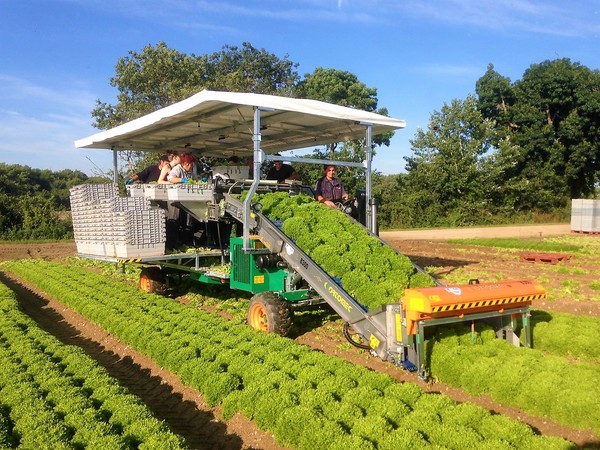
Mechanized harvesting of head salads
Despite competition from fresh-cut vegetables (mainly ready-to-eat leaf salads), head salads are still validly marketed. However, for maximum commercial yield, mechanized harvesting must carefully preserve product quality
Over the years, the spread of ready-made IV gamma salads has undermined part of the market for those in heads, which, despite this, are still confirmed as a rather profitable crop. However, like many crops that grow at ground level, it is necessary to ward off the onset of mold and/or rot, which could irreparably damage production. To this end, soil characteristics are crucial, as it is necessary to prefer, both in the open field and in greenhouses or under tunnels, loose soils with excellent drainage capacity. As a matter of fact, soil characteristics are critical, as it is necessary to prefer, both in the open field and in greenhouses or under tunnels, loose soils with excellent drainage capacity. Furthermore, given the brevity of the production cycle, in order to obtain good yields, it is important to take care of fertilization, providing adequate doses of fertilizer, mineral or preferably organic.
Cultivation. Head salads can be sown directly in the field, or seedlings developed in seedbeds are transplanted; the choice between the two procedures depends substantially on the climatic context and the time of year of the production cycle. Seedbed preparation involves breaking up any surface crust and finishing the tilled layer for maximum softness. A final rolling is also useful to slightly compact and level the soil surface so as to facilitate cultivation, especially with regard to irrigation operations. Normal planting spacing is 30-40 cm between rows and 20-30 cm on the row. In the case of direct seeding, in order to achieve the desired final planting density, taking into account failures, the distance on the row between individual seeds is about 10 cm. After emergence, manual or mechanical thinning is carried out to obtain the correct production density. Irrigation is preferably done with drip systems, which optimize water consumption and prevent excesses that could lead to the emergence of mold or fungus, as well as cause possible rot. Harvest time depends on weather conditions, planting time, area, and variety. Harvesting is usually staggered when the head has reached commercial size. As a rule, harvesting is done when head formation is complete, that is, 40-60 days after sowing or transplanting.
Manual harvesting. Makes use of specially shaped knives to cut the head at the collar while removing the outermost, diseased or unattractive leaves.
The main limitation of this solution concerns the posture of the workers, who work stooped toward the ground in a decidedly uncomfortable and tiring position.
To improve the situation, facilitating equipment can be used, such as trolleys equipped with seats skimming the ground so that they can operate while sitting instead of standing and stooping.
Mechanized harvesting. Almost always, self-propelled machines are used for the purpose, powered by classic endothermic engines (usually 50-70 Hp) or more modern electric motors (see box). Due to the absence of harmful gaseous emissions, electric models are particularly recommended for harvesting in confined environments, such as greenhouses and tunnels, but of course, their adoption is also suitable for the open field. Trailed models, to be coupled with tractors, are also available on the market.
Harvesters are equipped with a single- or double-blade oscillating cutter bar, usually between 1.2 and 2 m wide, with which several rows can be harvested at once. The bar cuts off the heads at the collar, which are then conveyed onto a conveyor belt, with the help of two side deflectors, to better direct the crop of the outermost rows toward the lift.
Alternatively, the head picker consists of a series of concentrically rotating pairs of toothed chains, similar to what is commonly adopted for corn headers. The transport mat is sloped upward, usually has a rubberized bottom for safer support of the heads and is equipped with teeth to prevent them from falling back by rolling. At the end of the transport module are the workers for hulling the heads and storing them in boxes, which are then stacked and transferred to the storage area on the machine platform or in special trailers. Self-propelled machines are often 4-wheel-drive and steerable, equipped with classic tires or with steel or, better, rubber tracks. The latter option is particularly advantageous when working on particularly soft soils since the significantly larger ground contact surface of the tracks, for the same weight as the machine, creates lower ground pressure and, thus, limited compaction. Traction is almost always hydrostatic, with the application of a hydraulic motor on each wheel, therefore with very smooth driving, even at very low forward speeds, speeds that, by the way, can be kept constant with cruise control. The cutter bar drives and its vertical movement, as well as those of the conveyor belts, are also hydraulic. Specifically, the harvesting header is kept at a constant height above the ground surface by monitoring dedicated electronic sensors.
It is precisely because of this feature that most salad harvesters can be easily converted from head to leaf.
Robotization. In the area of head salad harvesting as well, some studies are underway to automate harvesting. A prototype for scalar harvesting of salad heads, based on specific quality parameters, is being developed at the University of Cambridge. The main problems that have been faced concern the recognition of the heads due to the very changeable light conditions in the open field and variations in the vegetative densities of the produce. The prototype built consists of two video cameras, the first placed 2 m above the ground for the overall view of the harvesting area and the other near the harvesting arm. The machine is managed by a laptop computer, which analyzes the data provided by the two cameras and manages the sensors placed inside the robotic harvesting arm. Pneumatic actuators operate the cutting blade on the arm and the head retention mechanism.
Electric models in greenhouses
Tunnels and greenhouses are protected arrangements, where the microclimate that is created makes it possible to extend the useful growing period of vegetable production. Cultivation of salads, both cut and head, requires confined environments of significant size to allow optimal transit of a range of operating machinery. In addition to obviously affecting operators, gaseous pollutant emissions from endothermic engines can have a negative effect on crops, so over time, dedicated models have been developed for confined environment work that is electrically driven, using an externally recharged battery pack. Considering the powers involved are not high, harvesting makes advantageous use of the electric solution, best preserving the quality of the harvest.
Harvesting of bleached salads
To meet market needs, some salad varieties undergo procedures to improve their organoleptic qualities. Among these, bleaching (see Mondo Macchina 5-6 2023), which normally takes place in the field before harvesting, is very popular. The heads of endives typically have a rather open habit, and so to achieve whitening, they are closed on themselves by tying so that the central leaves do not photosynthesize and are, therefore, sweeter and crisper. Conversely, in the case of radicchio (for both varieties, Trevisana lunga and Chioggia), bleaching is achieved by removing the outermost leaves of the plant and preserving only the more compact heart. In any case, picking the heads in the field is done in the same way as for the other varieties.








